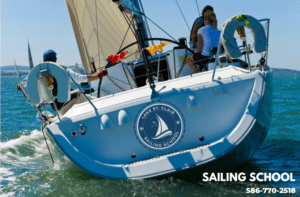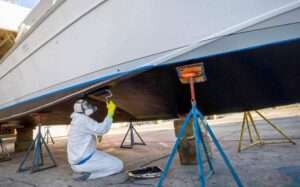Pre-Departure Checklist for Sailboats
Before Setting Sail:
- Weather Forecast: Check the weather conditions for your intended boating area and time frame.
- Vessel Inspection:
- Steering and Throttle: Ensure they operate smoothly.
- Lights: Verify all lights are functioning correctly.
- Fuel System: Inspect for leaks in the tank, lines, and carburetor.
- Engine Compartment: Check for oil leaks.
- Hoses: Examine for leaks, cracks, and tight clamps.
- Bilge: Drain water and secure the plug.
- Fuel Supply: Confirm sufficient fuel or know where to refuel.
- Battery and Extinguishers: Ensure they are fully charged and functional.
- ECOS and Lanyard: If equipped, check their condition.
- PFDs: Verify you have the required number and that they are in good condition.
- Float Plan: Leave a detailed plan with a reliable contact.
Required Equipment (Federal and State):
- State Registration and Numbering
- Certificate of Documentation (if applicable)
- Lifejackets (PFDs) for all passengers
- Throwable Type IV Cushion
- Visual Distress Signals
- Fire Extinguishers
- Proper Ventilation
- Sound-Producing Device(s)
- Navigation Lights
- Oil and Garbage Placards (if applicable)
- Marine Sanitation Device (if applicable)
- Navigation Rules (if applicable)
Recommended Equipment by ASA
- VHF Marine Radio
- Anchor and Tackle
- Charts, Navigation Tools, and Compass
- Fenders and Boat Hook
- Mooring Lines and Heaving Line
- Manual Bilge Pump
- Tool Kit
- Spare Parts
- Spare Battery
- Spare Propeller
- Extra Fuel and Oil
- Alternate Propulsion (paddles/oar)
- Flashlight and Batteries
- Search Light
- First Aid Kit
- Sunscreen
- Food and Water
- Extra Clothing
- AM/FM Radio
- Cellular Phone
- Binoculars
Safety Checks and Tests:
- Marine Radio
- Navigation and Anchor Lights
- Steering
- Tilt/Trim
- Bilge Pump
- Water in Bilges
- Fuel System
- Engine Fluids
- Boat Plug
- Electrical System
- Galley/Heating Systems
- Gauges
- Fuel Amount
- Anchor
- Load and Gear Security
- Passenger Emergency Procedures and Equipment Knowledge
- Lifejacket Fitting
Additional Considerations:
- Weather Forecast: Monitor conditions throughout your trip.
- Navigation: Use charts, GPS, and other navigational aids.
- Communication: Maintain radio contact and have a backup plan.
- Safety Practices: Follow boating rules and regulations.
Remember: By completing this checklist and following best practices, you can significantly reduce the risk of accidents and ensure a more enjoyable boating experience.
Spread the love



